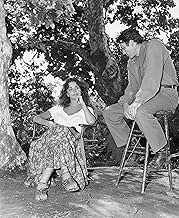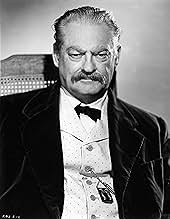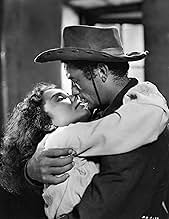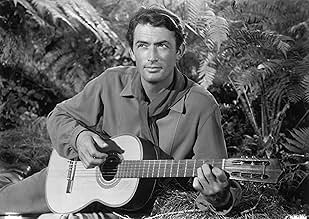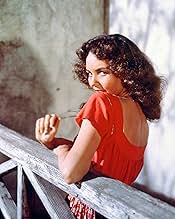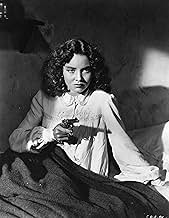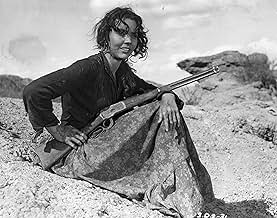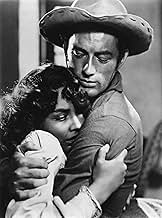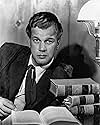NOTE IMDb
6,7/10
10 k
MA NOTE
La jolie métisse Pearl Chavez devient la pupille du premier amour de son père décédé et se retrouve déchirée entre ses deux fils, l'un bon, l'autre méchant.La jolie métisse Pearl Chavez devient la pupille du premier amour de son père décédé et se retrouve déchirée entre ses deux fils, l'un bon, l'autre méchant.La jolie métisse Pearl Chavez devient la pupille du premier amour de son père décédé et se retrouve déchirée entre ses deux fils, l'un bon, l'autre méchant.
- Nommé pour 2 Oscars
- 3 victoires et 4 nominations au total
Griff Barnett
- The Bordertown Jailer
- (non crédité)
John Barton
- Party Guest
- (non crédité)
Avis à la une
Well, it's obvious that Selznick was trying his best to recapture that GWTW magic...but this is an unbelievably inept failure. Here's what you can expect from this overblown sex-western:
--Jennifer Jones (in pancake make-up so orange that she put me more in mind of an Oompa-Loompa than the half-breed we're supposed to see) apparently directed to act as though she's Scarlett O'Hara with a lobotomy and bad grammar.
--Gregory Peck as rogue murdering rapist and the apple of his daddy's eye. At one point even doing a pretty decent vocal imitation of Clark Gable -- too bad it's just the voice.
--Lionel Barrymore lazily repeating his "It's a Wonderful Life" role from the same year -- wheelchair & grumpiness standing in for effort.
--Butterfly McQueen as kerchiefed ditzy maid. Hmmm, wonder where they got that idea?
All in all, a miserable movie experience. You'd think that since they cribbed from the best it'd have turned out better! Go figure.
--Jennifer Jones (in pancake make-up so orange that she put me more in mind of an Oompa-Loompa than the half-breed we're supposed to see) apparently directed to act as though she's Scarlett O'Hara with a lobotomy and bad grammar.
--Gregory Peck as rogue murdering rapist and the apple of his daddy's eye. At one point even doing a pretty decent vocal imitation of Clark Gable -- too bad it's just the voice.
--Lionel Barrymore lazily repeating his "It's a Wonderful Life" role from the same year -- wheelchair & grumpiness standing in for effort.
--Butterfly McQueen as kerchiefed ditzy maid. Hmmm, wonder where they got that idea?
All in all, a miserable movie experience. You'd think that since they cribbed from the best it'd have turned out better! Go figure.
Everything about 'Duel in the Sun' is overripe: the music, the photography (those red sunsets a la GWTW), the strong emotions and the climactic duel on a blazing desert sun by the two mismatched lovers. Indeed, the excesses are almost operatic in proportion--and yet, a viewer can get caught up in this sprawling western rightly termed "Lust in the Dust" by some reviewers. The rampant sensuality of the steamy scenes between Peck and Jones are emphasized by Dimitri Tiomkin's luscious background score which becomes blistering and intense for the climactic shootout. Overproduced, overacted, overwritten--it still entertains and makes us appreciate the genius of David O. Selznick whose hand on all of the material is quite evident. Jennifer Jones was nominated for her tempestuous Pearl Chavez (but lost to Olivia de Havilland for 'To Each His Own'). Lillian Gish deserved her Oscar nomination. And last but not least, let's not forget Walter Huston, who gives the most realistic and enjoyable performance in the entire film as The Sin Killer--a wickedly funny portrayal. Weakest aspect of the film is Gregory Peck's easygoing villain--his whole performance strikes a false note and is not the least bit convincing. He and Joseph Cotten should have switched their roles--Cotten always made a more believable villain than Peck. Selznick obviously was striving to make a western on the level of GWTW--even including Butterfly McQueen for comic relief. All in all, fun to watch if you don't take any of it seriously. Not exactly a work of art--but definitely worth watching. And, oh, that ripe technicolor!
King Vidor was a long-serving and much-respected Hollywood grandmaster who took a serious interest in movie-making
"Billy the Kid" and "Duel in the Sun" hold an important place in the history of the genre
These two films in particular, along with "Northwest Passage," show Vidor's romantic vision of backwoods America and his love of natural landscape; they share, too, an earthy quality which is missing from his more routine action Westerns, "The Texas Rangers" and "Man Without a Star."
Photographed in rich color, the visual magnificence of the film was manifested in the shots of the cowboys galloping across the rolling hills; in the spectacular confrontation between the McCanles forces who aimed to defend Spanish Bit with lead and the U.S. Cavalry; in the deep red sunset sequence with Lionel Barymore as "the lonely Senator"; and in that long shot of the surreptitious meeting between Lewt and his father on the hilltop at sunset
"Duel in the Sun" is extravagantly and grandiosely passionate and romantic and its characters are much larger than life A poignant scene was the tremendous moment between two legendary actors (Lionel Barrymore & Lillian Gish) when Laura Belle said to her husband "I'm a nuisance to you even to the end. It's the first time you've been in this room since that night./I loved you, Laura Belle. Yes, sir, I loved you."
Now, when a single movie offers murder, rape, attempted fratricide, train wreck, fiery sensual dance, drunkenness, religion, range wars, prostitution, sacred and profane love and sex as the principal motivation and not as an incidental subplot, and all that against an epic background of empire-building, well, it is for the first time in a Western in such a big scale
The film featured the story of Pearl Chavez whose past is dark as her coca-stained skin and who loves everybody but loves bad Lewt most often
Gregory Peck character as Lewt is barbaric, undisciplined, untamed, overwhelming He is a bad man, all bad, but he is also the lowest, dirtiest, meanest and cool, and he knows how to laugh and have a good time
Jennifer Jones as Pearl, is the 'prettiest girl ever to set foot on Spanish Bit.' She is a marvelous overwrought minx, wild and sexy
Joseph Cotton is the calm, educated, refined, pleasant son Jesse who ultimately sides with the railroad against his father He even threatens to cut the fence wire promising: "I'd rather be on the side of the victims than of the murderers."
Lionel Barrymore is the invalid Senator Jackson McCanles who orders his son, calling him a "Judas," to leave his ranch for as long as he lives
Lillian Gish is the delicate Laura Belle who blames her husband of spoiling Lewt and she let him do so ever since he was a child making him think that rules weren't made for him
Herbert Marshall plays Scott Chavez the condemned Southern aristocrat gentleman who sends his daughter to Laura Belle, his second cousin
Charles Bickford plays Sam Pierce, the boss who gets a little ranch of his own but never run across anybody he wanted to marry Besides, he never got up nerve enough to ask anybody
Impassions, pulsating, barbaric, and thunderous, the music matches perfectly the fervid emotionalism of the story
The film received only two Academy Awards nominations
Photographed in rich color, the visual magnificence of the film was manifested in the shots of the cowboys galloping across the rolling hills; in the spectacular confrontation between the McCanles forces who aimed to defend Spanish Bit with lead and the U.S. Cavalry; in the deep red sunset sequence with Lionel Barymore as "the lonely Senator"; and in that long shot of the surreptitious meeting between Lewt and his father on the hilltop at sunset
"Duel in the Sun" is extravagantly and grandiosely passionate and romantic and its characters are much larger than life A poignant scene was the tremendous moment between two legendary actors (Lionel Barrymore & Lillian Gish) when Laura Belle said to her husband "I'm a nuisance to you even to the end. It's the first time you've been in this room since that night./I loved you, Laura Belle. Yes, sir, I loved you."
Now, when a single movie offers murder, rape, attempted fratricide, train wreck, fiery sensual dance, drunkenness, religion, range wars, prostitution, sacred and profane love and sex as the principal motivation and not as an incidental subplot, and all that against an epic background of empire-building, well, it is for the first time in a Western in such a big scale
The film featured the story of Pearl Chavez whose past is dark as her coca-stained skin and who loves everybody but loves bad Lewt most often
Gregory Peck character as Lewt is barbaric, undisciplined, untamed, overwhelming He is a bad man, all bad, but he is also the lowest, dirtiest, meanest and cool, and he knows how to laugh and have a good time
Jennifer Jones as Pearl, is the 'prettiest girl ever to set foot on Spanish Bit.' She is a marvelous overwrought minx, wild and sexy
Joseph Cotton is the calm, educated, refined, pleasant son Jesse who ultimately sides with the railroad against his father He even threatens to cut the fence wire promising: "I'd rather be on the side of the victims than of the murderers."
Lionel Barrymore is the invalid Senator Jackson McCanles who orders his son, calling him a "Judas," to leave his ranch for as long as he lives
Lillian Gish is the delicate Laura Belle who blames her husband of spoiling Lewt and she let him do so ever since he was a child making him think that rules weren't made for him
Herbert Marshall plays Scott Chavez the condemned Southern aristocrat gentleman who sends his daughter to Laura Belle, his second cousin
Charles Bickford plays Sam Pierce, the boss who gets a little ranch of his own but never run across anybody he wanted to marry Besides, he never got up nerve enough to ask anybody
Impassions, pulsating, barbaric, and thunderous, the music matches perfectly the fervid emotionalism of the story
The film received only two Academy Awards nominations
David O. Selznick spent the rest of his life trying to top Gone With the Wind. What other mountains did he have to climb after making the most acclaimed motion picture ever?
In addition he had another obsession, his second wife Jennifer Jones. He was going to make her the greatest leading lady in the history of film.
Well he didn't succeed at either, but it wasn't for lack of trying. Jones herself was in a peculiar position similar to her husband's. She got an Oscar for her first feature film after she changed her name from Phyllis Isley to Jennifer Jones. Selznick knew that she couldn't play saints all her life as she did in The Song of Bernadette. So for this western answer to Gone With the Wind as Pearl Chavez she plays about as opposite a character from Bernadette Soubirous as you can get.
Duel in the Sun got mixed reviews by the critics, but the public ate it up. It's the story of the McCanless family, parents Lionel Barrymore and Lillian Gish and sons Joseph Cotten and Gregory Peck. Cotten is the good son, Peck the bad one. In fact as Lewt McCanless Peck played his worst character until Josef Mengele in Boys from Brazil.
A kissing cousin of their's Jennifer Jones comes to live with them. She's the offspring of an old beau of Lillian's, Herbert Marshall and the Indian wife he ran off with back in the day. Lillian and Herbert were kissing cousins also.
As Pearl Chavez, Jen gets the McCanless boys testosterone going into overdrive. Take one look at her and you can hardly blame them.
One of the not so hidden subtexts of Duel in the Sun is racism. Jennifer's good for a quick roll in the hay, but marriage is out of the question, at least for Gregory Peck. Barrymore's and Peck's racism is overt, the others not quite so, but it's still there.
The negotiations with Louis B. Mayer for Lionel Barrymore must have been interesting. Selznick's former wife was Irene Mayer, Louis's daughter.
One thing with Selznick, he spared no expense. He got the best in talent for this film. Dimitri Tiomkin did the score, King Vidor the direction, Ray Rennahan the color photography which is absolutely stunning.
He even got Bing Crosby to record Gotta Get Me Somebody to Love with Les Paul's guitar. Peck sang it in the film, Crosby's record sold a few platters.
He even got Orson Welles to do the off-screen narration if you don't recognize that voice.
It misses being a classic mainly because Selznick couldn't keep his hands off it. Sometimes the acting is about as subtle as a sledgehammer from all the performers. I'm willing to bet it's Selznick more than Vidor.
Yet it's good entertainment and Duel in the Sun does have its moments.
In addition he had another obsession, his second wife Jennifer Jones. He was going to make her the greatest leading lady in the history of film.
Well he didn't succeed at either, but it wasn't for lack of trying. Jones herself was in a peculiar position similar to her husband's. She got an Oscar for her first feature film after she changed her name from Phyllis Isley to Jennifer Jones. Selznick knew that she couldn't play saints all her life as she did in The Song of Bernadette. So for this western answer to Gone With the Wind as Pearl Chavez she plays about as opposite a character from Bernadette Soubirous as you can get.
Duel in the Sun got mixed reviews by the critics, but the public ate it up. It's the story of the McCanless family, parents Lionel Barrymore and Lillian Gish and sons Joseph Cotten and Gregory Peck. Cotten is the good son, Peck the bad one. In fact as Lewt McCanless Peck played his worst character until Josef Mengele in Boys from Brazil.
A kissing cousin of their's Jennifer Jones comes to live with them. She's the offspring of an old beau of Lillian's, Herbert Marshall and the Indian wife he ran off with back in the day. Lillian and Herbert were kissing cousins also.
As Pearl Chavez, Jen gets the McCanless boys testosterone going into overdrive. Take one look at her and you can hardly blame them.
One of the not so hidden subtexts of Duel in the Sun is racism. Jennifer's good for a quick roll in the hay, but marriage is out of the question, at least for Gregory Peck. Barrymore's and Peck's racism is overt, the others not quite so, but it's still there.
The negotiations with Louis B. Mayer for Lionel Barrymore must have been interesting. Selznick's former wife was Irene Mayer, Louis's daughter.
One thing with Selznick, he spared no expense. He got the best in talent for this film. Dimitri Tiomkin did the score, King Vidor the direction, Ray Rennahan the color photography which is absolutely stunning.
He even got Bing Crosby to record Gotta Get Me Somebody to Love with Les Paul's guitar. Peck sang it in the film, Crosby's record sold a few platters.
He even got Orson Welles to do the off-screen narration if you don't recognize that voice.
It misses being a classic mainly because Selznick couldn't keep his hands off it. Sometimes the acting is about as subtle as a sledgehammer from all the performers. I'm willing to bet it's Selznick more than Vidor.
Yet it's good entertainment and Duel in the Sun does have its moments.
No need to recap the plot.
One thing about this overblown fandango— once seeing it, you won't forget it. How could anyone when everything is done to such tasteless excess. Poor Pearl (Jones). Apparently, Jones was told her part was that of a hot-blooded wench, which she unfortunately took to mean parboiled. It's hard not to laugh at the first hour when she acts like a nympho on steroids, tossing hair and leering wildly like pampas grass in a windstorm. Not far behind is that vintage ham Lionel Barrymore doing his usual blustery bit, like we won't get his hard-bitten patriarch unless he takes it into hyper speed. And who could have guessed that the usually constricted and constrained Gregory Peck could actually over-act. I think it was his first and last time—good thing, too.
It's possible to go on about the unrelenting excess— the sunsets that appear to hemorrhage, a musical score that's as necessary as sugar on molasses, and a loony ending that defies parody. But you get the idea. Too bad so much money and effort went into such a generally overheated result. Only Cotten, Gish and the black stallion come through unscathed. I'm thinking RKO could have made a dozen worthwhile programmers on the same budget. As things turned out, Selznick did his beloved Jones no favors with this one. It's hard to believe the man responsible for Gone with the Wind (1939) is also responsible for this swollen mess.
One thing about this overblown fandango— once seeing it, you won't forget it. How could anyone when everything is done to such tasteless excess. Poor Pearl (Jones). Apparently, Jones was told her part was that of a hot-blooded wench, which she unfortunately took to mean parboiled. It's hard not to laugh at the first hour when she acts like a nympho on steroids, tossing hair and leering wildly like pampas grass in a windstorm. Not far behind is that vintage ham Lionel Barrymore doing his usual blustery bit, like we won't get his hard-bitten patriarch unless he takes it into hyper speed. And who could have guessed that the usually constricted and constrained Gregory Peck could actually over-act. I think it was his first and last time—good thing, too.
It's possible to go on about the unrelenting excess— the sunsets that appear to hemorrhage, a musical score that's as necessary as sugar on molasses, and a loony ending that defies parody. But you get the idea. Too bad so much money and effort went into such a generally overheated result. Only Cotten, Gish and the black stallion come through unscathed. I'm thinking RKO could have made a dozen worthwhile programmers on the same budget. As things turned out, Selznick did his beloved Jones no favors with this one. It's hard to believe the man responsible for Gone with the Wind (1939) is also responsible for this swollen mess.
Le saviez-vous
- AnecdotesAccording to King Vidor, director Josef von Sternberg was hired only as a lighting expert by David O. Selznick in order to give his wife--and the film's star--Jennifer Jones a more glamorous look.
- GaffesThe opening shows saguaro cacti in the valley. The film is supposed to take place in Texas, but southern Arizona is the only place in the US with saguaro cacti, unless they've been transplanted.
- Citations
The Sinkiller: Under that heathen blanket, there's a full-blossomed woman built by the devil to drive men crazy.
- Versions alternativesThe original "roadshow" version ran 144 minutes. The additional 16 minutes, over the commonly-shown 128 minute version, consisted of a musical "prelude," an "overture" (which contained a spoken prologue, by Orson Welles), and exit music, but no additional scenes in the film. The two additional opening sequences were each inadvertently given the other's label.
- ConnexionsEdited into Histoire(s) du cinéma: Une histoire seule (1989)
Meilleurs choix
Connectez-vous pour évaluer et suivre la liste de favoris afin de recevoir des recommandations personnalisées
Détails
- Date de sortie
- Pays d’origine
- Langue
- Aussi connu sous le nom de
- Duelo al sol
- Lieux de tournage
- Sociétés de production
- Voir plus de crédits d'entreprise sur IMDbPro
Box-office
- Budget
- 8 000 000 $US (estimé)
- Montant brut aux États-Unis et au Canada
- 20 408 163 $US
- Montant brut mondial
- 20 428 771 $US
- Durée
- 2h 26min(146 min)
- Rapport de forme
- 1.37 : 1
Contribuer à cette page
Suggérer une modification ou ajouter du contenu manquant


